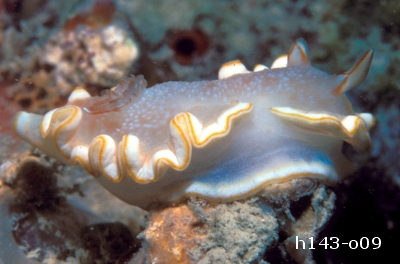Glossodoris poliahu from Hawaii [1]
December 20, 2006
From: Scott Johnson


Hi Bill,
I notice there is not yet a species page for the Hawaiian Glossodoris poliahu Bertsch & Gosliner, 1989. Here's a bit of information on the species.
This species was unnamed when first pictured by Bertsch & Johnson, who referred to it as "snowflake" due to the scattering of small white spots over the dorsum. Bertsch & Gosliner subsequently retained the snowy theme when they described it after Poli'ahu, the Hawaiian goddess of the snow covered mountain.
The dorsum has a translucent gray to brown background with relatively crowded slightly elevated small white spots. Especially on larger specimens, the white spots are mostly missing in some small patches, leaving "spots" of background color with a single central white spot. The overall effect of this is to give the dorsum a slightly ocellated appearance. The mantle margins, which undulate more in larger specimens, are mostly bright white with a thin orange line above and below the very edge of the mantle, which is thin and white. Rhinophores are whitish with a vertical orange-brown line on the anterior and posterior sides; the line splits in two on the lower posterior portion of the rhinophore. Similar colored lines run up the angular edges of the gills.
Locality: Oahu, 5 - 15m, Hawaii, USA, Pacific, on ledges and walls in coral over basalt. Length: to 38mm. Upper: h143-o06 38mm. Pupukea, Oahu, Hawaiian Islands. In ledge at night. Depth 13m. 10 Oct 1979. Middle: h143-o09 29mm. Ewa, Oahu, Hawaiian Islands. Under rock. Depth 15m. June 1977. Lower: h143-o02 35mm. Makua, Oahu, Hawaiian Islands. Exposed on cliff. Depth 5m. July 1977. Photographer: Scott Johnson.
Most often, this species is found individually (rarely paired), usually on ledges or the vertical sides of reefs at depths of 10 meters and deeper. Rarely specimens can be found as shallow as about 5 meters. They seem equally active both day and night. As far as we know, this species is endemic to the Hawaiian Islands. I have seen it around the islands or Oahu and Hawaii, and have heard of sightings around Maui. When I was doing a lot of diving in Hawaii in the late 1970s and mid 1980s, it was uncommon, but certainly not rare.
-
Bertsch, H. & Johnson, S. (1982) Hawaiian Nudibranchs. Oriental Publishing Co, Honolulu. 112 pp.
-
Bertsch, H & Gosliner, T. M. (1989) Chromodorid nudibranchs from the Hawaiian Islands. The Veliger 32(3): 247-265.
I have three additional photos I will send in a separate message [#19037 ].
Scott Johnson
uwkwaj@yahoo.com
Johnson, S., 2006 (Dec 20) Glossodoris poliahu from Hawaii [1]. [Message in] Sea Slug Forum. Australian Museum, Sydney. Available from http://www.seaslugforum.net/find/19036
Dear Scott,
Thanks for the information. I always welcome a readymade Fact Sheet. It's good to see these photos. Externally it looks quite similar to some of the colour forms of Glossodoris rufomarginata but one distinctive difference is that in that species the rhinophores are orange or brown with a white or plae line up the anterior and posterior midlines, while in G. poliahu we have the reverse - a white rhinphore with an orange or brown line.
Best wishes,
Bill Rudman
Related messages
-
Glossodoris poliahu from Hawaii [2]
From: Scott Johnson, December 20, 2006
